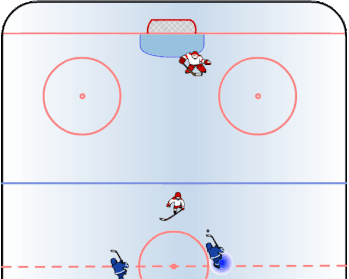How Do You Get an Assist in Hockey? An assist in hockey happens when a player helps score a goal. This can be by passing or deflecting the puck.
Assists are key to team success in hockey. They show teamwork and skill. Assists are counted in player stats, just like goals. They can be primary or secondary assists, depending on their involvement. Understanding how to get an assist can improve your game.
It’s not just about scoring goals but also setting them up. In this post, you will learn the basics of earning assists. We will explore the rules and strategies behind it. This will help you become a more effective player on the ice.
Introduction To Hockey Assists
In hockey, scoring a goal is a team effort. Assists play a crucial role in this effort. Understanding assists is key to appreciating the game’s complexity. This section will introduce you to hockey assists.
Definition Of An Assist
An assist in hockey is a pass that leads to a goal. It credits the player who helped set up the goal. Usually, the last two players to touch the puck before the goal are awarded assists. This makes hockey unique. It acknowledges the importance of teamwork.
Importance In The Game
Assists highlight a player’s vision and skill. They show how well players work together. Assists also contribute to a player’s statistics. This can affect their career and team dynamics. Teams with high assist counts usually perform better. They show strong cooperation and strategy.

Credit: en.wikipedia.org
Rules Governing Assists
The Rules Governing Assists in hockey are clear. Assists play a crucial role in the game. They recognize players who help set up goals. Knowing these rules can improve your understanding of the game.
Official NHL Rules
The National Hockey League (NHL) has specific rules for assists. An assist is awarded to the last two players who touch the puck before a goal. The only condition is that no defender touches it. The first player to touch the puck gets the primary assist. The second player gets the secondary assist.
Key Points:
- Two assists per goal maximum
- Primary assist: last player before the goal scorer
- Secondary assist: second last player before the goal scorer
Exceptions And Special Cases
There are exceptions to the standard rules. Not every goal involves two assists. Here are some special cases:
- Unassisted Goals: If a player scores without teammate help, no assist is given.
- Rebounds: If the puck rebounds off the goalie, the last two players to touch the puck still get assists.
- Deflections: If a player deflects the puck into the net, the players who passed the puck get assists.
These rules ensure fair recognition. They highlight teamwork in scoring goals.
| Situation | Assist Awarded |
|---|---|
| Unassisted Goal | No |
| Rebounds | Yes |
| Deflections | Yes |
Types Of Assists
Types of assists in hockey play a crucial role in the game. Understanding these types can help fans appreciate the nuances of playmaking. Assists are not just about passing the puck. They involve timing, positioning, and strategic thinking. Let’s explore the different types of assists.
Primary Vs Secondary Assists
Primary assists occur when a player makes the initial pass leading to a goal. This pass directly sets up the scoring opportunity. It often involves quick thinking and precise execution.
Secondary assists happen when a player contributes to the goal with an earlier pass. This pass might not be the final one, but it helps set up the play. Both types of assists are vital in hockey.
Special Teams Assists
Special teams assists occur during power plays or penalty kills. In a power play, one team has more players due to a penalty on the other team. Assisting in this situation requires quick decision-making and exploiting the numerical advantage.
During a penalty kill, the team with fewer players tries to stop the opposing team from scoring. Assists in this situation often involve defensive plays and clearing the puck effectively.
Understanding these assist types enhances the appreciation of the game’s complexity. Each assist type showcases different skills and strategies, making hockey an exciting sport to watch.
Techniques For Earning Assists
Getting an assist in hockey is a vital skill. It requires more than just passing the puck. Players need to develop several techniques to make effective plays. Below are some key techniques for earning assists.
Passing Skills
Good passing skills are essential. A well-timed pass can lead to a goal. Players should practice different types of passes:
- Short passes: Useful in tight spaces. Quick and precise.
- Long passes: Useful for quick breakouts. Requires accuracy.
- Backhand passes: Can surprise defenders. Needs practice.
A great pass is both accurate and well-timed. Always aim for the teammate’s stick. Ensure the puck is easy to control.
On-ice Vision And Awareness
Having good vision on the ice is crucial. Players must constantly scan the ice. Look for open teammates. Predict opponents’ moves.
Here are some tips to improve on-ice vision:
- Keep your head up: Avoid looking at the puck. Scan the ice.
- Read the play: Anticipate where your teammates will be. Know the game plan.
- Use peripheral vision: Be aware of players around you. See the entire rink.
Being aware of the situation helps in making smart decisions. It leads to more assists.
Famous Players Known For Assists
Hockey is a fast-paced game. Assists are crucial in creating scoring opportunities. Famous players known for assists have made significant marks in the sport. These players have a knack for setting up their teammates for goals. Let’s explore some of the historical greats and current leaders in assists.
Historical Greats
Some players have changed the way assists are viewed in hockey history. Here are a few:
- Wayne Gretzky – Known as “The Great One,” Gretzky holds the record for most career assists with 1,963.
- Mark Messier – Messier is second on the all-time assists list with 1,193 assists.
- Ron Francis – Francis ranks fifth in assists with 1,249, showcasing consistent playmaking.
Current Leaders
Today’s game features some incredible assist leaders. These players continue to impress with their vision and skill:
| Player | Team | Assists |
|---|---|---|
| Connor McDavid | Edmonton Oilers | Over 360 assists |
| Sidney Crosby | Pittsburgh Penguins | Over 800 assists |
| Patrick Kane | Chicago Blackhawks | Over 700 assists |
These players make the game exciting to watch. Their ability to create scoring chances is unmatched. The art of assisting is alive and well in hockey.
Credit: proambitions.com
Frequently Asked Questions
What Is An Assist In Hockey?
An assist in hockey is awarded to players who pass the puck to a teammate who then scores.
How Many Assists Can Be Awarded Per Goal?
Up to two assists can be awarded per goal in hockey.
Do Assists Count As Points In Hockey?
Yes, assists count as points in a player’s statistics.
Can A Goalie Get An Assist In Hockey?
Yes, a goalie can get an assist by passing the puck to a teammate who scores.
Does A Deflection Affect An Assist In Hockey?
Yes, if the puck deflects off an opponent, the pass can still count as an assist.
How Are Assists Different From Goals In Hockey?
Goals are scored by shooting the puck into the net. Assists are given to players who help set up the goal.
Are Secondary Assists Important In Hockey?
Yes, secondary assists are important as they recognize the players involved in the play leading to a goal.
Do Penalties Affect The Awarding Of Assists?
No, penalties do not affect the awarding of assists in hockey.
Can A Player Get An Assist On Their Own Goal?
No, a player cannot get an assist on their own goal in hockey.
Conclusion
Earning an assist in hockey is a team effort. It requires quick thinking and precise passes. Good positioning and awareness are essential. Practice is key to improving these skills. Remember, assists are just as important as goals. They help build strong team dynamics.
Celebrate each assist as a victory. Keep honing your skills on the ice. Enjoy every moment of the game. Hockey is all about teamwork and sportsmanship.






